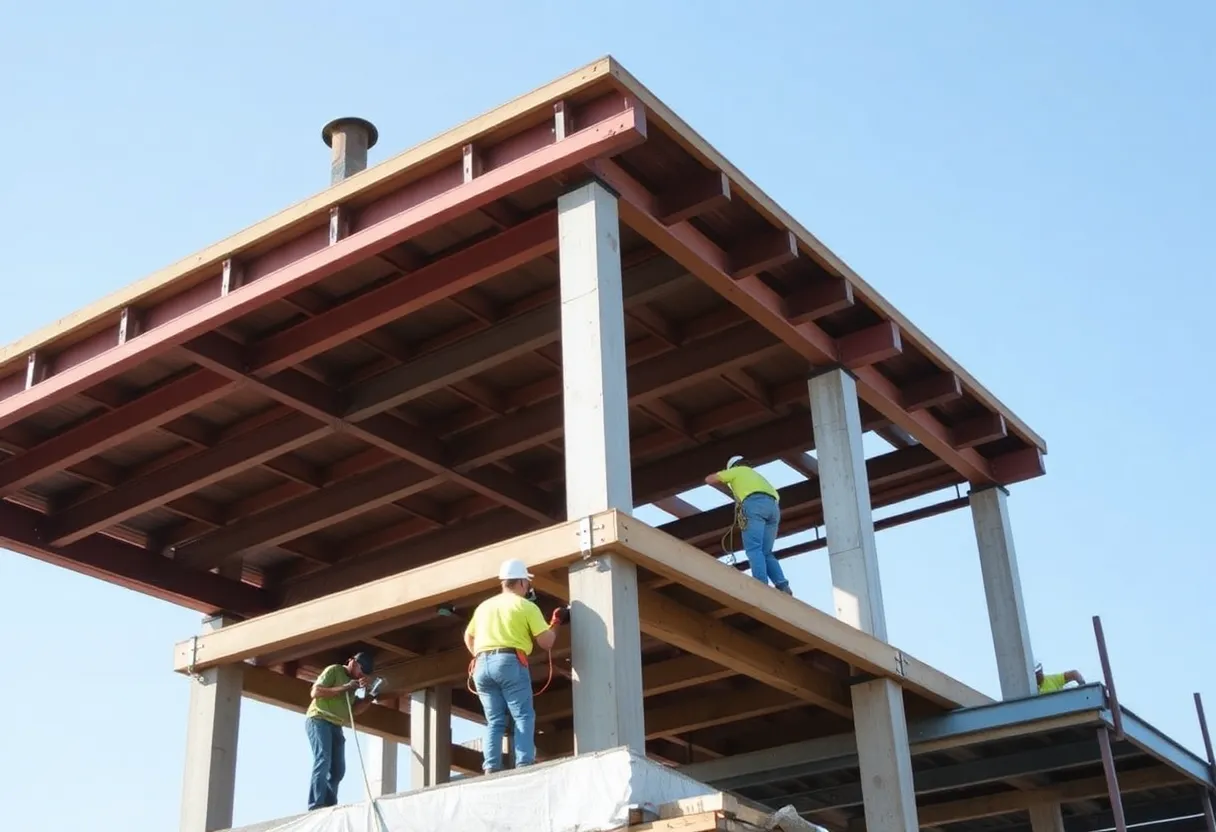Global, September 17, 2025
News Summary
The global Building Information Modeling market is on a rapid growth path, driven by AI, cloud platforms, sustainability targets and wider use of BIM for operations and asset management. Market value is projected to rise markedly, supported by demand for 4D scheduling and 5D cost integration. Large programs at airports demonstrate centralized cloud platforms managing thousands of documents, speeding reviews and issue resolution, while digitally delivered hotel projects show streamlined coordination and lower waste. Pilots of digital twins aim to link construction data with long-term maintenance, making BIM a core lifecycle platform for the built environment.
Global BIM Market Set to Triple by 2033; Airport and Hotel Projects Show Digital Shift
The global market for Building Information Modeling (BIM) is on a fast growth path, rising from an estimated USD 8.53 billion in 2024 to a projected USD 23.74 billion by 2033, reflecting a compound annual growth rate of 11.8% for the 2025–2033 period. The shift is driven by a combination of smarter software, cloud platforms, sustainability goals and expanded use of BIM beyond design into operations and asset management.
Why the market is expanding
Major forces pushing BIM adoption include growing use of artificial intelligence (AI) and machine learning (ML) to automate routine tasks such as clash detection, predictive maintenance and design optimization. Cloud-based BIM platforms are also gaining ground because they enable real-time collaboration and centralized access to models, reduce on-site IT needs and support remote teams. Public policy is reinforcing the trend, with several governments requiring BIM for large infrastructure projects to improve transparency and reduce cost and schedule overruns. Finally, demand for 4D scheduling and 5D cost integration is helping teams plan time and money more accurately before construction begins.
Market segmentation and coverage
The market analysis covers software and services, on-premises and cloud deployments, lifecycle stages from pre-construction through operations, and applications such as design, planning, modeling and asset management. Forecasts are presented at global, regional and country levels, with trend analysis from 2021 through 2033 across building types that include commercial, industrial, residential and government projects.
Real-world digital construction: an airport example
A major international airport has been expanding use of a cloud construction platform to support a large capital program approaching USD 1.8 billion. The airport is handling passenger numbers that have returned to roughly 32 million per year and expects growth toward higher future volumes. The program includes more than 140 projects, over 1,500 platform users, and the onboarding of over 200 supplier companies into a shared data environment. Centralized digital records have been used to manage complex operations that involve more than 200 firms and strict aviation compliance requirements.
Measured benefits in operations and delivery
The airport’s adoption of the platform sped up internal review processes by a factor of 3.5 versus traditional methods. In a busy year the team submitted about 19,000 documents and completed nearly 6,000 reviews across 60 projects. Issue resolution was reported as running roughly three times faster, and formal request-for-information (RFI) workflows were about 1.5 times faster. The program also amassed approximately 500,000 embedded documents tied to about EUR 1 billion of projects, showing how digital records scale with investment.
Testing digital twin and lifecycle links
The airport is piloting a digital twin tool to see how asset, space and system information can be linked into the existing model. The pilot focuses on integration choices, resource commitments and how new sources of operational data may overlap with older systems. The broader goal is to make data flow bidirectional between planning/design and operations so that construction inputs feed long-term maintenance and asset decisions.
Smaller project example: a digitally delivered city hotel
A mid-market, 151-bedroom hotel project in a central city location used a digital-first delivery method and won a national BIM excellence award. The project ran eight floors of new build and included public spaces such as a ground-floor bar and restaurant. Although BIM was not contractually required, the team adopted standardized information management processes under ISO 19650, used 3D models to coordinate architects, engineers and specialist contractors, and reported gains in certainty, lower waste and smoother collaboration.
Workforce and sector activity
A construction group reported recent recruitment of 300 specialists focused on green energy projects and indicated ongoing hiring to meet demand. Other projects reported include construction of electricity distribution hubs and the opening of energy-efficient public leisure centers built to advanced standards, demonstrating how BIM and digital workflows play across sustainability and capacity programs.
What this means for the industry
The combined push from AI/ML, cloud platforms, government mandates and lifecycle-focused tools is moving BIM from a design support into a central, data-driven platform for construction delivery and long-term asset management. Firms adopting cloud BIM and integrating schedule and cost dimensions should expect improved predictability, faster approvals and clearer evidence of completed work. Pilots of digital twins and connected environments will determine how tightly construction data is linked to operations in the years ahead.
FAQ
What is the current global BIM market size and forecast?
The market was estimated at USD 8.53 billion in 2024 and is projected to reach USD 23.74 billion by 2033, with a CAGR of 11.8% for 2025–2033.
What are the main drivers of BIM growth?
Key drivers include AI and machine learning, cloud-based platforms, sustainability goals and the move to use BIM for asset management and operations beyond design.
How are cloud BIM platforms changing project delivery?
Cloud platforms enable real-time collaboration, centralized access to models, improved version control and reduced on-site IT needs, which speeds reviews and issue resolution.
What operational gains have digital platforms shown in large programs?
Examples include faster review cycles (3.5x), quicker issue resolution (3x), faster RFI handling (1.5x) and the ability to manage tens of thousands of documents and reviews across many projects.
What is the role of digital twins in construction and operations?
Digital twin pilots aim to link construction data to long-term asset records and operations, enabling bidirectional data flow from planning to maintenance and back to design.
Key features at a glance
| Feature | Detail |
|---|---|
| 2024 market size | USD 8.53 billion |
| 2033 projection | USD 23.74 billion |
| CAGR (2025–2033) | 11.8% |
| Main growth drivers | AI/ML, cloud platforms, sustainability, asset management |
| Large program example | ~1,500 users, >200 suppliers, >140 projects, ~USD 1.8B capital program |
| Measured efficiency gains | Review 3.5x faster; issue resolution 3x faster; RFI 1.5x faster |
| Document scale | ~19,000 documents submitted and ~6,000 reviews across 60 projects in a year; ~500,000 embedded documents tied to ~EUR 1B of projects |
| Digital twin activity | Pilot testing for asset, space and system integration and lifecycle linking |
Deeper Dive: News & Info About This Topic
Additional Resources
- ENR: Dublin Airport takes off into construction cloud & digital twin
- Wikipedia: Digital twin
- Autodesk: Customer story — DAA (Dublin Airport Authority)
- Google Search: Dublin Airport BIM construction cloud
- BAM: Newmarket Square Hotel in Dublin wins BIM excellence award
- Google Scholar: Newmarket Square Hotel BIM
- The Fishing Daily: BIM announces 2025 Taste the Atlantic young chef ambassadors
- Encyclopedia Britannica: Taste the Atlantic
- Dublin Gazette: Young Dublin chef selected for BIM Taste the Atlantic
- Google News: BIM Taste the Atlantic
Author: Construction FL News
The FLORIDA STAFF WRITER represents the experienced team at constructionflnews.com, your go-to source for actionable local news and information in Florida and beyond. Specializing in "news you can use," we cover essential topics like product reviews for personal and business needs, local business directories, politics, real estate trends, neighborhood insights, and state news affecting the area—with deep expertise drawn from years of dedicated reporting and strong community input, including local press releases and business updates. We deliver top reporting on high-value events such as the Florida Build Expo, major infrastructure projects, and advancements in construction technology showcases. Our coverage extends to key organizations like the Associated Builders and Contractors of Florida and the Florida Home Builders Association, plus leading businesses in construction and legal services that power the local economy such as CMiC Global and Shutts & Bowen LLP. As part of the broader network, including constructioncanews.com, constructionnynews.com, and constructiontxnews.com, we provide comprehensive, credible insights into the dynamic construction landscape across multiple states.





